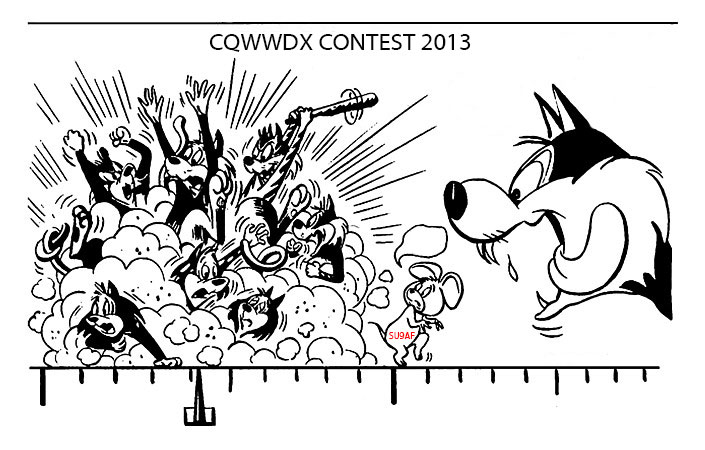
After the Contest
October 28, 201310m AMAZING CW QSO
October 29, 2013Best Practices for DXpedition Operating
This week, I want to address DXpeditioners directly. DXpeditions during the past few months have been a problem. To be honest, some of the operating has been very poor. (That’s a polite version of what I have been reading.)
Some of the DXpedition operators recruited for these operations seem to have forgotten – or never learned – much of what has been written about how to manage their operations. As a result, reactions to these operations in many cases have been vile. Much of the negative reaction is coming from DXers who see their opportunities for a QSO diminishing. Additional reaction is coming from non-DXers who have had their own operating unnecessarily disrupted by the pileups. In these cases, the non-DXers have gone to the source, the DXpedition frequency. Setting off a circus there is not difficult at all.
There have been numerous attempts in the “local media” to pinpoint the reasons for this behavior, and some of it has been off the mark. But increasingly, DXers are beginning to understand: virtually every instance of poor pileup behavior can be attributed to poor pileup management. The nature of a DXpedition pileup mirrors the skill of the DXpedition operator. A carefully managed pileup will run with little disruption to the remainder of the band and minimize frustration. To begin, here are some suggestions for making the most of your pileup.
Best Practices for DXpedition Operating:
1. Check your transmit and receive frequencies before starting.
2. Use split operation from the beginning
3. Maintain a rhythm of regular transmissions. No long silences.
4. Do not use excessive speed on CW. Slow down when signals are weak.
5. Reduce speed further on CW to communicate with the pileup.
6. Sign your call sign at least every minute.
7. Issue calling instructions after every QSO: EU UP5 or NA UP 5-10
8. Minimize Pileup width: Suggest Max 5kHz CW and 15kHz SSB.
9. Move receive frequency in a generally regular pattern.
10. Repeat corrected call signs so everyone is confident of being correctly logged.
11. Work and log dupes, it’s quicker.
12. Don’t leave the pile-up hanging: Keep the callers informed about QRT/QSY, etc.
13. Maintain a moderate, but “in-charge attitude.”
*This list, and more about these Best Practices will appear on the pages of the DX University very soon.
In the remainder of this space today, I will mention two of these points. The first is point number 8. Several DXpeditions have been observed working stations on the “WARC” bands over virtually the whole range of frequencies. This is simply unacceptable, and really unnecessary. The DX operator who says he can’t hear without spreading the pile so widely frankly hasn’t learned how to manage his pileup. The suggested limits are and must be adequate – by definition. The bands don’t belong solely to DXers. To believe that they do is nothing if not arrogant. If there are too many stations calling within those limits, steps must be taken to limit the number of stations calling. Roger, G3SXW points out:
http://dx-code.org/DXpednew.html#split
As responsible (DXped) operators, be considerate of other users. It’s their band too. The more rare the DXpeditions QTH, the larger the likely pileup and this can produce pileups that spread out beyond what is reasonable. A 5 to 8 KHz spread for CW and 10 to 15 KHz spread for SSB are considered by many DXpedition operators to be reasonable.
Roger adds: Additional good reading on this topic can be found at http://www.dxuniversity.com/dxped/tools.php
Another important practice is Point #12: not to leave the pileup hanging. There has been considerable complaining about DXpedition stations moving from their frequencies without notice, etc. If a QRX or QSY to another band is necessary, inform those DXers in the pileup. We all know that frustration is a primary catalyst for chaos. Considerable frustration can be avoided by being careful to let the callers know what you plan to do.
Of course, there are other exacerbating conditions. In particular, some expeditions to very rare places don’t have the resources to match the rarity of their location. I believe the PT0S expedition to St. Peter and St. Paul Rocks is one of these. This is basic and conceptual planning. PT0S a “specialty DXpedition,” concentrating on the low-bands and on six meters. This expedition was billed as a specialty event, but that seems to have gone unnoticed. With only four operators, this leaves one operator responsible for impossible task of meeting the demand on all of the other bands. It is likely that SP&P is just too rare for four operators and a concentration on the low bands and six meters. As a result, the callers are spread over fewer bands, increasing the demands on the pileup management skills of the operators. My observation is that the low band pileup management is excellent, while the operation on the other bands leaves something to be desired.
The WeeklyDX™ Helpful Hints No. 35 from the DX University™*


